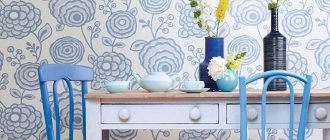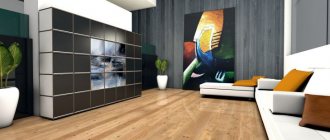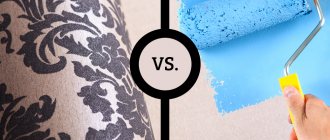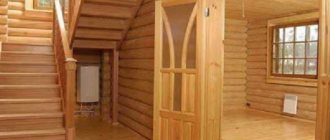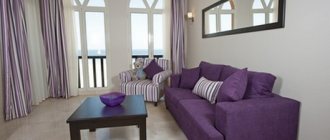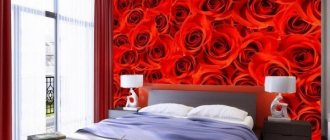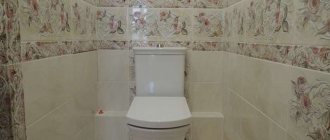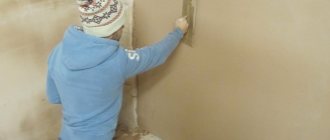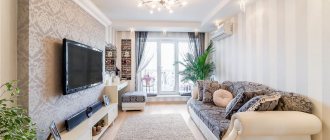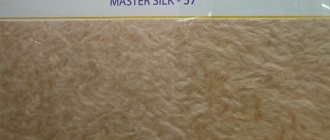Ceramic tiles have been and remain the most popular material for finishing bathrooms. However, it is not at all necessary to seal the entire toilet or the entire bathroom with tiles. Tile is desirable where there is a high probability of contamination and exposure to moisture. In other areas, other types of finishing can be used.
The tiles go well with painting, plaster, wood paneling and, of course, wallpaper. By the way, combined finishing is very popular nowadays.
There is no need to be afraid of wallpaper in the toilet. They do not “cheapen” the interior at all, because this solution is classic and elegant. Of course, if you paste wallpaper from floor to ceiling, such a finish most likely will not last long. And from a sanitary and hygienic point of view, this option is undesirable, especially if this is not a guest bathroom, but the main toilet for the whole family. But if you combine wallpaper with tiles , issues of hygiene and durability will lose their urgency.
Let's talk about the pros, cons and features of this solution, and be inspired by the examples in the photo.
Wallpaper in the toilet: advantages
1. Savings. Tiles tend to be more expensive than wallpaper. The cost of the work also varies: they charge much more for laying tiles than for gluing wallpaper. If you combine tiles with wallpaper , the repair will be significantly cheaper than in the case of total tiling.
2. Comfort. With wallpaper, the bathroom looks more homely, warmer and more comfortable. It does not resemble an operating room or some other not very pleasant room.
3. Visual effect. Combining tiles and wallpaper in a bathroom is usually done by horizontally dividing the walls into upper and lower levels. Wallpaper on top, tiles on bottom. This division visually reduces the height of the ceiling and increases the width of the room. As a result, the toilet does not look like a pipe.
4. Ease of implementation of “redesign”. If the bottom is tiled with laconic neutral tiles and wallpaper is pasted on top, changing the decor after a few years will not be difficult. All you need to do is re-paste the wallpaper and change the decor, accessories, and plumbing fixtures. With a minimum of effort and expense, it will be possible to radically change the appearance of the bathroom.
If the toilet is covered with tiles from floor to ceiling, changing the design becomes difficult and costly. The sight of the bathroom may tire you over time, but you have to endure it. True, there is still a way out - painting the tiles, for example. But this is also an intermediate, temporary option.
5. Stylistic component. Wallpaper is a wonderful assistant in the matter of “style formation”. The texture, color and pattern of wallpaper play an important role in shaping the overall picture and influence the perception of the interior. Well-chosen wallpaper helps express style and effectively emphasizes it.
We'll talk about which wallpaper to choose for a particular style below.
Wallpaper in the toilet: cons
1. Inadmissibility of wet and rough cleaning. Wallpaper, of course, can be wiped, but only with a dry or slightly damp cloth. Wet it thoroughly, use chemicals, scrub thoroughly - it won't work. Whatever one may say, wallpaper becomes dirty over time. With tiles, of course, it is much easier to maintain close to ideal cleanliness.
2. Risk of peeling and cracking. If there is high humidity in the toilet (and this happens often), the wallpaper may peel off and come off a little at the joints. In addition, they often crack in the corners, especially when it comes to new buildings. These nuances can spoil the appearance of the room and give it an unkempt appearance.
3. Bad forecast if neighbors flood. A toilet, all of whose wall surfaces are covered with tiles, will most likely not suffer anything (unless the ceiling is damaged). The wallpaper will probably be hopelessly damaged. You'll have to re-glue it.
Where to begin
Many people puzzle over how to arrange a small toilet in an apartment. One of the options is a design with a niche (see photo below).
A toilet with a niche is the most advantageous design, since in this case there will be additional space for installing, for example, a boiler or simply decorative items. Initially, you will need to select those materials that are most in harmony with the interior of the apartment as a whole, since through the use of suitable types of finishing, a unified atmosphere and harmony will be created in the apartment.
You can decorate such a toilet using tiles with various images, for example, in the form of marble or made to look like artificial stone. The niche itself will look great with a wood finish, and it is important that the color scheme matches the tiles. For example, if you choose marble tiles, then the wood should be dark, with a slight grayish tint.
The design of a small toilet with a niche, judging by the photo, can be varied. For example, you can lay a mosaic along one of the walls. It is recommended to use only smalt that will match the overall interior in shade, and you should also give preference to monotony.
Otherwise, the appearance of the toilet room will be overloaded, and it will not look very aesthetically pleasing.
On a note!
For example, you can put an extra roll of paper, a spare brush, or a few packs of wet wipes in your cabinets.
If you have extra space in a small toilet in an apartment, then you can create a design with cabinets based on the photo. They can be used to store all the toiletries and bath items that you don't use very often.
Wallpaper in the toilet: which one to choose and how to combine it with tiles?
As already mentioned, wallpaper actively participates in the formation of style. If a specific direction is chosen for the toilet, then the wallpaper should be selected accordingly.
So, for a bathroom in Provence or country style, wallpaper with a delicate flower pattern is ideal. The same samples would be appropriate in modern classics.
Wallpaper with a metallic pattern, as well as black-and-white and silver-gray pieces with ornaments, will fit perfectly into luxurious American classics and art deco.
Wallpaper with large green leaves is popular for bathrooms. They are very organic in the modern atmosphere, including the Scandinavian one. These wallpapers are also suitable for eco-friendly designs.
In general, the natural theme for toilets is now relevant. Living green walls are created in bathrooms, surfaces are decorated with moss, real wood cuts are used for countertops, etc. These details create the illusion of spaciousness and freshness in a small room. To maintain eco-themes, not only “green-leaf” wallpapers are suitable, but also samples made from natural materials (or imitation ones). We are talking about the so-called grasscloth wallpaper, that is, fibrous. They are expensive, but they last a long time. They are more resistant to moisture and cleaning than their paper counterparts.
If you don’t like the designs, ornaments, or textures, you should turn your attention to plain wallpaper without a pronounced texture or pattern. It will harmoniously fit into any style surroundings.
As for the combination method , the most common option is dividing the walls by height. There are tiles below, wallpaper on top. To what height should I lay the tiles? There is no single canon. You can do it in a way that is convenient for the owners.
It must be taken into account that the tiles perform not only an aesthetic, but also a protective function. Because, unlike wallpaper, it can be polished to a shine. It would be logical to cover with tiles the surface of the walls that may be subject to contamination and moisture.
In general, the classic height of the panels (and the tiles perform exactly this function when dividing walls) is up to the upper edge of the back of the chair. Of course, the height of chairs varies, but on average it is somewhere around 90-95 cm .
However, the height of the “tile panel” should also depend on the size of the tile, because it is very desirable to do without trimming. Here it is better to make a decision in the direction of increasing rather than decreasing the height. For example: if you are laying tiles 12 cm high, it is preferable to take 8 whole tiles (the cladding height will be 96 cm), rather than 7 and a half. If the height of the tile is 40 cm, it would be more correct to lay 3 rows of whole tiles (it will be 120 cm), and not 2 with a core.
If the toilet has a washbasin, you can raise the lining level higher by covering this wet area with a protective apron. But if the goal is to save on tiles, you can go the other way - make a common lining below the sink, and form a separate apron from tiles, mosaics, or glass near the washbasin.
Dividing walls by type of panel is not the only way to use wallpaper in the toilet. You can cover almost everything with tiles, and stick wallpaper as an accent, on any separate area - for example, above the toilet. Or cover 2-3 walls of the toilet completely with tiles, and cover one wall away from wet areas with wallpaper to its full height. In general, there is a lot to think about when planning a renovation.
Kinds
When decorating a toilet, it is preferable to use the following wallpaper:
- Liquid. Such wallpapers are very similar to plaster, as they are sold in powder form. Before covering the walls with this wallpaper, they should be well leveled and treated with a primer with water-repellent properties. By mixing wallpaper granules with water, you get the consistency of a regular finishing mixture, which is applied to the prepared surface.
- Washable (non-woven). The main advantage of this type of wallpaper is the presence of an outer layer that can resist moisture. Pasting such wallpaper is quite simple if you pay attention to the joints and carefully smooth the canvas.
- Vinyl. They are often chosen for finishing a toilet, since such wallpapers are highly resistant to moisture. To glue such material, you should use a special glue that can hold a heavy canvas. In addition, due to the significant thickness of the sheets, such wallpaper can only be glued end-to-end.
- Glass wallpaper. This type of coating does not absorb liquids and odors, and is also not afraid of detergents. These wallpapers include fiberglass, have an interesting texture and can be painted.
- Ceramic. Such wallpapers are durable and highly resistant to moisture. They are made of thin porcelain stoneware and mounted using special adhesive mixtures.
